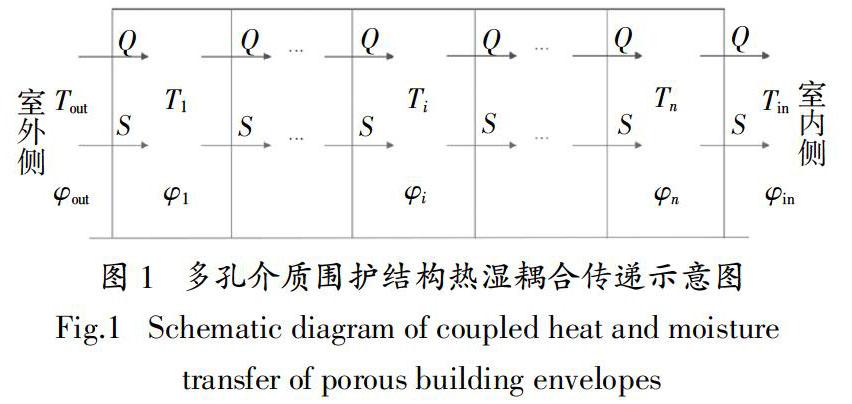两种建筑围护结构动态热湿耦合传递模型对比与验证
2020-12-06陈友明董文强鲍洋房爱民
陈友明 董文强 鲍洋 房爱民



摘 要:对以相对湿度为湿驱动势的两种热湿耦合传递模型(Künzel模型和Liu & Chen模型)进行了对比与全面验证,包括理论验证、模型间验证和实验验证. 使用Fortran程序和COMSOL软件同时进行模拟,模拟结果分别与解析解、其他模型模拟解和单/双侧受控边界条件下的实验数据进行对比,模拟结果与对比值之间有良好的一致性. 将两模型模拟结果进行对比后发现,在吸湿区内低相对湿度段,两模型差异不大;而在吸湿区末段(相对湿度逐渐增大至接近95%),Künzel模型不再能够准确模拟湿分布. 此研究在吸湿范围内充分验证了两个模型,并为将来的热湿耦合模型验证提供参考.
关键词:热湿耦合传递;模型对比;全面验证;模拟;吸湿区
中图分类号:TU111.4 文献标志码:A
Comparisons and Validation of Two Dynamic Models for
Coupled Heat and Moisture Transfer in Building Envelopes
CHEN Youming?,DONG Wenqiang,BAO Yang,FANG Aimin
(College of Civil Engineering,Hunan University,Changsha 410082,China)
Abstract:A comparison and comprehensive verification, including theoretical verification, inter-model verification and experimental verification, was performed on two models, the Künzel model and the Liu & Chen model for the hygrothermal simulation of porous building envelopes, which are driven by relative humidity. The simulations were also carried out by two computation tools, self-programmed Fortran code and COMSOL Multiphysics for the two models. The simulation results were compared with analytical solutions, simulation solutions of other models and experimental data under single/double-sided controlled boundary conditions. The verification showed that the simulation results of the two models agreed well with the comparison values. Through the comparison between the simulation results of the two models, it was found that the two models have slight difference in the low relative humidity section in the hygroscopic range; while in the end of the hygroscopic range (relative humidity gradually increases to nearly 95%), the Künzel model was no longer able to accurately simulate the distributions of moisture. The investigations in this study demonstrate that the two models are fully validated within the hygroscopic range and provide references for the verification of future hygrothermal models.
Key words:coupled heat and moisture transfer;model comparison;comprehensive validation;simulation;hygroscopic range
多孔介質建筑围护结构中的热湿耦合传递对于围护结构的热湿性能、室内空气品质和结构耐久性具有显著影响. 因此研究热湿耦合传递对预测和评估建筑围护结构内部的温度场和湿度场的分布、提高围护结构的热湿性能、抑止霉菌生长和提高结构耐久性具有重要的意义[1].
热湿耦合传递的研究已逾70年,很多理论模型已被前人提出. 然而,由于湿驱动势和假设条件的不同,各模型分别适用于不同的情况,而未有一广泛适用的模型来描述热湿耦合传递过程. Künzel[2]提出以相对湿度为湿驱动势建立热湿耦合模型,该模型把湿传递(蒸气传递、液态水传递)视为纯粹的扩散过程,均使用Fick定律来描述,并使用3个实验案例验证了该模型. 该模型在WUFI软件中得到进一步应用[3]。Liu & Chen[4]同样以相对湿度为湿驱动势建立热湿耦合模型,但该模型把液态水传递过程视为毛细压力驱动的一种“流”,使用Darcy定律来描述,并使用EN 15026案例[5]和HAMSTAD基准案例[6-7]验证了该模型. 两模型均未经过充分的全面验证——未进行实验验证或只进行了简单的实验验证。
Künzel和Karagiozis[8]把热湿模拟模型的严格验证分为三步:1) 模拟结果与解析解对比;2) 模拟结果与具有明确的材料物性参数和边界条件的实验室测试数据对比;3) 模拟结果与暴露于真实外部边界条件下的实测数据对比. 而本文将对上述两模型进行全面验证,包括理论验证(与解析解对比)、模型间验证(与其他模型模拟解对比)和单/双侧受控条件下的实验验证. 之所以选择这两个模型是因为:1) 两模型的湿驱动势都是相对湿度,易于测量;2) 在多层墙体交界面处的湿驱动势是连续的,这使得模拟计算易于实现. 通过本文对这两种模型的对比和全面验证,以期发现两模型的优势与不足,为多孔建筑围护结构热湿耦合传递模型的研究提供参考.
1 两种模型
为了给研究者提供可靠的热湿耦合传递模型,以便准确地预测和评估多孔建筑围护结构的热湿分布和热湿性能,本文将对Künzel模型和Liu & Chen 模型进行全面验证.
全面验证包括理论验证、模型间验证和实验验证. 在下文中所有的验证案例,两模型都使用Fortran程序和COMSOL软件进行数值模拟. 两模型的详细描述如下.
1.1 物理模型及假设条件
多层多孔墙体的热湿耦合传递过程如图1所示.两模型的假设条件如下:不考虑空气传递;忽略重力效应;温度保持在0 ℃以上(忽略结冰和冻融影响);孔隙内仅存在气液两相;湿空气被视为理想气体;仅考虑一维热湿传递.
式中:δa = 2 × 10-7 × (T + 273.15)0.81 /Pambient,δa为静止空气的水蒸气渗透率,kg/(m·s·Pa);μ为水蒸氣扩散阻力因子;Dw为湿扩散率,m2/s;Pambient为周围环境空气压力,Pa;φ为相对湿度,%;T为温度,K;t为时间, s;Psat为饱和水蒸气分压力,Pa;w为材料体积含湿量,kg/m3;ρm为干材料的密度,kg/m3;cp,m为干材料的比热容,J/(kg·K);h1v为汽化潜热,J/kg;λ为导热系数,W/(m·K);cp,1为液态水的比热容,J/(kg·K).
式中:gn为通过墙体表面的湿流,kg/(m2·s);qn为通过墙体表面的热流,W/m2;βp为墙体表面的传质系数,kg/(m2·s·Pa);φ为空气相对湿度;φsurf为墙体表面相对湿度;psat为空气饱和水蒸气分压力,Pa;psat,surf为墙体表面饱和水蒸气分压力,Pa;h为墙体表面的传热系数,W/(m·K);T为空气温度,K;Tsurf为墙体表面温度,K;α为墙体外表面的太阳辐射吸收率;qsolar为太阳辐射强度,W/m2;下标e/i分别表示墙体外/内表面.
1.5 两模型的区别
Künzel模型统一采用Fick扩散定律来描述水蒸气扩散量和液态水传递量[2,9]. 但实质上,液态水的毛细传递是一种“流”,而不是“扩散”. 而且Künzel模型认为建筑材料内蒸气扩散、液态水传递这两种流动的方向相反,忽略了两种流动的相互作用,将二者看作两个相互独立的过程[10].
Liu & Chen模型采用Fick扩散定律来描述水蒸气扩散量;采用Darcy定律来描述液态水传递量. 且该模型中湿扩散系数Dw包含了液态水传递和水蒸气扩散两部分,也就是说Dw和K1、δp之间存在函数关系,关系式为K1 = (Dw ξ - δp Ps)φ/(RD Tρ1)[11].
1.6 模型求解方法
下文所有验证案例中,两模型都使用Fortran程序和COMSOL软件进行数值求解.在Fortran程序中使用Crank-Nicholson格式[12]离散热湿控制方程,使用牛顿迭代法把非线性方程组转化为线性方程组,使用高斯消元法求解线性方程组. 使用Fortran程序模拟时,时间步长范围为60~3 600 s,空间步长范围为2~10 mm,收敛标准为10-4,最大迭代次数为30.
2 模型验证
对Künzel模型和Liu & Chen模型的全面验证(理论验证、模型间验证和实验验证)在本节中实现. 两模型都使用Fortran程序和COMSOL软件进行模拟. 模拟结果和解析解、其他模型模拟解以及实验数据对比来验证两模型的准确性. 同时也完成了两模型模拟结果之间的对比. 用最大相对误差评估模拟结果与解析解、其他模型模拟解之间的一致性. 用平均误差(ME)和均方根误差(RMSE)评估模拟结果与实验数据之间的一致性.
下文中,“Künzel+Fortran”、“Künzel+COMSOL”、“Liu & Chen+Fortran”和“Liu & Chen+COMSOL”分别是Künzel模型和Liu & Chen模型使用Fortran程序和COMSOL软件的模拟结果.
2.1 理论验证
采用HAMSTAD基准案例2[6]作为理论验证的案例. 该案例描述了等温条件下单层各向同性墙体的湿分布. 由于不考虑室内外的温度差异,该案例可得到一解析解. 外侧环境温度和相对湿度分别是20 ℃和45%,内侧环境温度和相对湿度分别是20 ℃和65%. 墙体初始温度和相对湿度分别是20 ℃和95%. 该墙体材料的热湿特性在文献[6]中给出. 模拟持续1 000 h,100 h、300 h和1 000 h时墙体中含湿量分布结果如图2所示.
两模型使用Fortran程序和COMSOL软件的模拟结果与解析解的对比如图2所示. Künzel+Fortran结果与解析解的最大相对误差在100 h、300 h、1 000 h时分别为2.562%、1.06%、0.45%. 相应地,Liu & Chen + Fortran结果与解析解的最大相对误差在100 h、300 h、1 000 h时分别为2.623%、1.072%、0.45%. 可以看出,两模型的模拟结果与解析解之间吻合良好,且Fortran程序与COMSOL软件的模拟结果也是十分一致的.
上述4个验证案例中,Künzel模型和Liu & Chen模型的模拟结果与解析解、其他模型模拟解和实验数据之间有良好的一致性. 当相对湿度较低时,Künzel模型和Liu & Chen模型的模拟结果间的差异很小,且相对湿度模拟值的误差都比温度模拟值的误差大. 当相对湿度逐渐增大直至超出吸湿区范围时,模拟值与现有对比值(其他模型模拟解或实验数据)的偏差逐渐变大. Liu & Chen模型的模拟结果比Künzel模型更接近現有对比值,这在图3中尤为明显,当相对湿度逐渐接近95%时,Künzel模型已经不再能够准确模拟湿分布.
3 结 论
本文对两种以相对湿度为湿驱动势的热湿耦合传递模型(Künzel模型和Liu & Chen模型)进行了全面验证——理论验证、模型间验证和实验验证. 用自编程的Fortran程序和COMSOL软件对两模型进行数值模拟. 验证结果表明,两模型的模拟结果与解析解、其他模型模拟解和实验数据有良好的一致性. 两模型的相对湿度模拟值的误差都比温度模拟值的误差大,这些误差来源于相对湿度传感器测量的不准确、模拟用的材料特性与实际值不同、计算输入参数与实际值的差异和模型本身的不足.
本文对Künzel模型和Liu & Chen模型进行了对比,结果表明:
1)当相对湿度较低时,Künzel模型和Liu & Chen模型的模拟结果间的差异很小.
2)当相对湿度逐渐增大直至超出吸湿区范围
时,模拟值与对比值的偏差逐渐变大,Künzel模型不能准确模拟湿分布.
通过两模型的对比,模型模拟结果与解析解、其他模型模拟解、实验结果在吸湿范围内吻合良好,从而在吸湿范围内充分验证了两个模型. 而在吸湿区末段(相对湿度小于但接近95%),Liu & Chen模型比Künzel模型更准确和可用. 至于超出吸湿区范围时(相对湿度>95%),两模型的适用性有待下一步研究.
这项研究为多孔建筑围护结构热湿耦合传递领域的研究人员在预测建筑围护结构内的温度和水分含量分布、改善建筑物湿热性能、预测霉菌生长风险以及提高结构耐久性等方面的进一步分析和研究提供了依据。
参考文献
[1] 刘向伟. 夏热冬冷地区建筑墙体热、空气、湿耦合迁移特性研究[D]. 长沙:湖南大学土木工程学院,2015:2—17.
LIU X W. Investigation of the coupled heat,air and moisture transport in building walls in hot summer and cold winter zone [D]. Changsha:College of Civil Engineering,Hunan University,2015:2—17. (In Chinese)
[2] K?NZEL H. Simultaneous heat and moisture transport in building components [R]. Verlag Suttgart:Fraunhofer IRB,1995:38—40.
[3] 黄祖坚,孙一民,MUSSO F. 北美典型气候区建筑围护结构HM模拟及分析[J]. 湖南大学学报(自然科学版),2019,46(3):130—140.
HUANG Z J,SUN Y M,MUSSO F. North America typical climate zones building envelope HM simulation and the analysis [J]. Journal of Hunan University (Natural Sciences),2019,46(3):130—140. (In Chinese)
[4] LIU X W,CHEN Y M,GE H,et al. Numerical investigation for thermal performance of exterior walls of residential buildings with moisture transfer in hot summer and cold winter zone of China [J]. Energy and Building,2015,93:259—268.
[5] EN 15206 Hygrothermal performance of building components and building elements—assessment of moisture transfer by numerical simulation [S]. London:British Standard Institution,2007:17—21.
[6] HAGENTOFT C E. Methodology of HAM- modeling:Report R-02:8 [R]. Gothenburg:Department of Building Physics,Chalmers University of Technology,2002:8—50.
[7] 刘向伟,陈国杰,陈友明. 墙体热、湿及空气耦合传递非稳态模型及验证[J]. 湖南大学学报(自然科学版),2016,43(1):152—156.
LIU X W,CHEN G J,CHEN Y M. Modeling of the transient heat,air and moisture transfer in building walls [J]. Journal of Hunan
University (Natural Sciences),2016,43(1):152—156. (In Chinese)
[8] K?NZEL H,KARAGIOZIS A. 2-Hygrothermal behaviour and simulation in buildings [M]//HALL M R. Materials for Energy Efficiency and Thermal Comfort in Buildings. Cambridge,UK:Woodhead Publishing,2010:54—76.
[9] GOTO Y,WAKILI K G,FRANK T,et al. Heat and moisture balance simulation of a building with vapor-open envelope system of subtropical regions [J]. Building Simulation,2012,5(4):301—314.
[10] 郭興国. 热湿气候地区多层墙体热湿耦合迁移特性研究[D]. 长沙: 湖南大学土木工程学院,2010:10.
GUO X G. Research on coupled heat and moisture transfer characteristics of multilayer walls in hot and humid climate [D]. Changsha:College of Civil Engineering,Hunan University,2010:10. (In Chinese)
[11] HAGENTOFT C E. HAMSTAD WP2 modeling,version 4:Report-02:9[R]. Gothenburg:Department of Building Physics,Chalmers
University of Technology,2002:1—3.
[12] 陶文铨. 数值传热学[M]. 2版. 西安:西安交通大学出版社,2001:32—37.
TAO W Q. Numerical heat transfer [M]. 2nd ed. Xian:Xian Jiaotong University Press,2001:32—37. (In Chinese)
[13] MELIN C B,HAGENTOFT C E,HOLL K,et al. Simulations of moisture gradients in wood subjected to changes in relative humidity and temperature due to climate change [J]. Geosciences,2018,8(10):378.
[14] MELIN C B,BJURMAN J. Moisture gradients in wood subjected to relative humidity and temperatures simulating indoor climate variations as found in museums and historic buildings [J]. Journal of Cultural Heritage,2017,25:157—162.
[15] MELIN C B,GEB?CK T,HEINTZ A,et al. Monitoring dynamic moisture gradients in wood using inserted relative humidity and temperature sensors [J]. E-Preservation Science,2016,13:7—14.
[16] BRATASZ L,KOZLOWSKA A,KOZLOWSKI R. Analysis of water adsorption by wood using the Guggenheim-Anderson-de Boer equation [J]. European Journal of Wood and Wood Products,2012,70(4):445—451.
[17] RODE C,ClORIUS C O. Modeling of moisture transport in wood with hysteresis and temperature dependent sorption characteristics [C]//Proceedings of Performance of Exterior Envelopes of Whole Buildings IX,2004. Oak Ridge,TN,USA:Oak Ridge National Laboratory, 2004:1—15.
[18] KUMARAN K. IEA annex 24 final report,vol.3,task 3:material properties[R]. Leuven:IEA,Acco Leuven,1996:14—132.
[19] RAFIDIARISON H,R?MOND R,MOUGEL E. Dataset for validating 1-D heat and mass transfer models within building walls with hygroscopic materials[J]. Building and Environment,2015,89:356—368.
[20] DELPHIN. Simulation program for the calculation of coupled heat,moisture,air,pollutant,and salt transport [DB/OL]. [2019-7-13]. http://bauklimatik-dresden.de/delphin/index.php?aLa=en.
[21] VOLOLONIRINA O,COUTAND M,PERRIN B. Characterization of hygrothermal properties of wood-based products - impact of moisture content and temperature [J]. Construction and Building Materials,2014,63:223—233.
[22] GOESTEN A J P M. Hygrothermal simulation model:damage as a result of insulating historical buildings [D]. Januari:Building Physics and Services,Eindhoven University of Technology,2016:54—129.
[23] TARIKU F,KUMARAN K,FAZIO P. Transient model for coupled heat,air and moisture transfer through multilayered porous media [J]. International Journal of Heat and Mass Transfer,2010,53(15/16):3035—3044.
